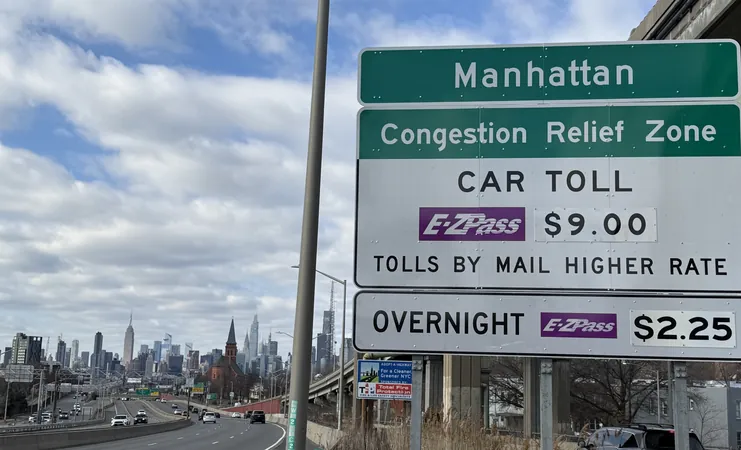
Is New York's Congestion Pricing the Next Battle for the Soul of the City?
2025-01-07
Author: Kai
Overview of New York City's Congestion Pricing
Last weekend, New York City unveiled its much-anticipated congestion pricing toll system, sparking a whirlwind of opinions and reactions from its inhabitants. While the move is lauded as a bold step towards managing traffic and enhancing public transport, the discourse surrounding it reveals stark divides within the city. Ironically, in a metropolis known for its resilience and diversity, the introduction of this policy has some individuals claiming their 'freedom' has been violated, and that sentiment is unfortunately gaining traction.
How the System Works
At its core, the congestion pricing program is straightforward: a once-per-day fee will be charged to vehicles entering the most congested areas of Manhattan, specifically below 60th Street, with costs varying based on vehicle size and time of day. The goal is to reduce traffic snarls that have plagued this urban sprawl for decades and improve the aging public transit systems, using revenue generated from the toll to fund necessary upgrades.
Historical Context
Historically, similar systems have demonstrated success in cities like London and Stockholm, which reported reduced congestion and improved air quality post-implementation. However, the New York City version diverges from its predecessors, grappling with the city's notorious car culture and the backlash from residents who feel their driving privileges are under threat. Although a significant proportion of New Yorkers—about 55%—do not own cars and many rely on public transit, those who do drive in the city often voice their frustrations loudly.
Public Reaction and Criticism
Critics of the congestion pricing plan have emerged from all corners, with some local media fanning the flames of discontent. For instance, tabloid headlines sensationalize the plight of 'just regular New Yorkers' who, according to them, have been disenfranchised by bureaucratic measures. Their grievances often come across as exaggerated, yet they resonate with a certain audience that feels overwhelmed by the changes headed their way.
Media Narrative and Public Sentiment
Most disconcertingly, this narrative proliferates through platforms that previously championed unrestricted driving rights, suggesting an insidious fear of modernization underpinned by allegations of government overreach. The New York Post, notorious for amplifying these sentiments, often publishes articles that appear to speak for the aggrieved drivers—claiming they are victims of a city that has forgotten its roots.
Global Trends in Urban Planning
In the wider context, New York's congested streets reflect a reality faced by many major cities around the globe. Urban planners and policymakers are increasingly recognizing the need for more sustainable approaches to transportation, often infuriating traditionalists whose identities are deeply tied to car ownership. The irony that New York's congestion pricing is riding the waves of historical contempt for public intervention underscores a deep-rooted struggle.
The Path Forward
However, there is hope. As other cities have demonstrated, with public engagement and effective communication, it is possible to turn resistance into acceptance. The key is not only to ensure a smoother driving experience for those who must use their cars but also to inspire newcomers to embrace alternative modes of transportation. The ultimate goal is a bustling city conducive to residents' needs—where the historic subway system, bus services, and bike lanes flourish, making New York an exemplary model of modern urban living.
Conclusion
As New Yorkers navigate through this transition period, it remains essential for city officials to foster dialogue and transparency. How effectively the congestion pricing plan functions will not only influence local traffic patterns but will set a precedent for other cities considering similar measures. The looming question is whether residents will adapt to this new normal or continue to resist a change that could potentially free their city from the grips of gridlock.
The congestion pricing initiative is not merely a policy change; it's a potential turning point for how urban life is navigated and experienced in New York City. As this dramatic transformation unfolds, the stakes are high—not just for the city’s future, but for the residents who call it home. Will this be the moment that marks a significant shift towards a more sustainable urban environment? Only time will tell.




 Brasil (PT)
Brasil (PT)
 Canada (EN)
Canada (EN)
 Chile (ES)
Chile (ES)
 Česko (CS)
Česko (CS)
 대한민국 (KO)
대한민국 (KO)
 España (ES)
España (ES)
 France (FR)
France (FR)
 Hong Kong (EN)
Hong Kong (EN)
 Italia (IT)
Italia (IT)
 日本 (JA)
日本 (JA)
 Magyarország (HU)
Magyarország (HU)
 Norge (NO)
Norge (NO)
 Polska (PL)
Polska (PL)
 Schweiz (DE)
Schweiz (DE)
 Singapore (EN)
Singapore (EN)
 Sverige (SV)
Sverige (SV)
 Suomi (FI)
Suomi (FI)
 Türkiye (TR)
Türkiye (TR)
 الإمارات العربية المتحدة (AR)
الإمارات العربية المتحدة (AR)